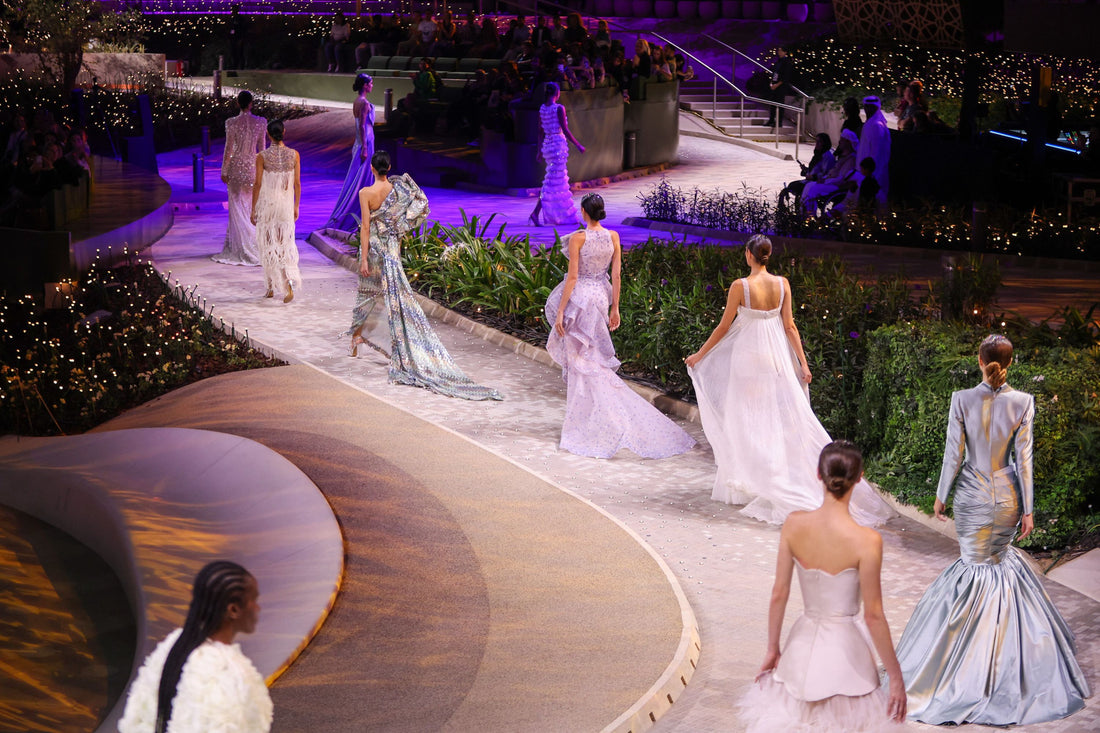
5 Highlights from the Fashion Industry’s Presence at COP28
Share
AFI Insider
The 28th annual United Nations Climate Change Conference, COP28, held in Dubai, UAE from 30 Nov until 12 Dec, 2023, was a pivotal platform for discussions on sustainability, particularly within the fashion industry.
Several panels at COP28 brought together industry leaders, policymakers, and NGOs to discuss solutions for fashion's sustainability challenges.
The "Fashion Charter" event, hosted by the UN, focused on collaborative action, promoting policy changes and financial support for a sustainable fashion future.
Just a few weeks before COP28 took place (and a few days after Joburg Fashion Week) Vestiaire Collective shared an AI-video of bales of clothing falling from the sky and cluttering New York City’s Time Square. The clothes were strewn all over the place, almost becoming a landfill in the middle of the world famous attraction. As they filled up the area, more clothes fell. It was shocking. But it served its purpose.
The video was announcing that Vestiaire Collective, which is a popular second-hand luxury fashion re-seller, will no longer be retailing fast fashion brands on its platform. Part of a three-year plan to kick out all fast fashion from the re-seller, this was a significant stride in the company’s commitment to building a more circular economy.
There is a movement to change the way people consume fashion. From sustainable methods of production, to circularity, there are many stakeholders in the fashion industry who are helping to bring awareness to issues of textile waste and fashion overconsumption.
Such discussions have happening more regularly the industry, including at the recent AFI Masterclass at Joburg Fashion Week (which you can watch in full, here) and also at COP28, which ended earlier this week.
Here are some key takeaways from the COP28 conference, highlighting the industry’s commitment to a sustainable future.
The Fashion's Big Problem
The fashion industry has been a major contributor to pollution and climate change for a while, mainly thanks to fast fashion. According to a press release by the UNs The Fashion Charter, the fashion industry is estimated to contribute 4-8% of global greenhouse gas emissions. The industry's climate impact spans the entire supply chain. While the industry has been talking about being more eco-friendly and sustainable, the fashion industry is still figuring out how to keep its promise of reducing the environmental impact of making clothes.
Though brands have committed to cutting their carbon footprint, most of the damage comes from the manufacturing process, and making big changes will cost money. During COP28, conversations on how the industry can take positive steps towards sustainability, were explored. Despite the substantial contribution to global trade and employment, the industry needs systemic change to achieve its net-zero goal by 2050.
Stella McCartney’s Major Presence
British fashion designer, Stella McCartney, who has been a trailblazer in sustainable fashion, showcased her commitment to green fashion innovation at COP28. In collaboration with LVMH, she highlighted material innovators like Radiant Matter and Keel Labs, featuring bio-based sequins and seaweed-based fibre.
McCartney emphasized her dedication to fossil fuel reduction and circular design, with upcoming initiatives including collaborations with Mango Materials and Air Carbon. McCartney's sustainable innovation exhibit marked a notable contribution to the conference.
Innovations and Solutions
There are already companies and scientists who are innovating new methods of making textiles that will aid in reducing fashion’s impact on the environment. In September, the Wall Street Journal reported that there are scientists that are exploring how to make yarn from carbon emissions, creating alternatives to leather by using leftover shellfish bits that are both cheap and plentiful. Others are exploring new textiles to break the fashion industry's reliance on resource-hungry cotton and polyester.
At COP28 "Sustainability 3.0" was a major talking point. It is not just about being eco-friendly and ethical in making clothes, but also about advocating for systemic changes through legislation and pushing for regulations that reward sustainable practices and discourage harmful ones.
The fashion industry is exploring diverse avenues to shrink its environmental footprint, emphasising a growing interest in renewable energy sources to decarbonise production processes and power textile manufacturing.
Fashion Bodies Make A Noise
There were a number of fashion organisations that made important statements at COP28. The Fossil Fuel Fashion campaign, highlighted the fashion industry's reliance on fossil fuels. It called for a shift towards renewable energy sources, sustainable materials, and circular business models to improve the fashion industry.
Organizations like the Global Fashion Agenda, Fashion Revolution, Stand.Earth, and Action Speaks Louder also played a crucial role at Cop28. Through panels, workshops, and exhibitions, they raised awareness about the environmental impact of fast fashion and advocated for systemic change towards sustainability.
The message is simple: a phase-out of fossil-fuel-based materials, and a need for the industry to transition towards more sustainable alternatives.
The Sustainable Fashion Show
In a sign that COP28 was taking the fashion industry seriously, the inaugural Sustainable Fashion Show took place, spotlighting designers dedicated to ethical and eco-conscious practices. The show unveiled collections that showcased innovative materials, production processes, and design techniques, paving the way for a more sustainable future in fashion.
Featuring designers from around the world, each presented collections crafted with upcycled fabrics, biodegradable materials, natural dyes, and closed-loop production systems. This showcase illustrated the myriad ways designers are embracing sustainability without sacrificing style.
